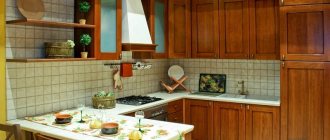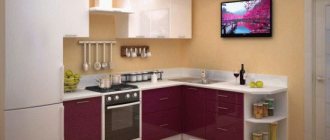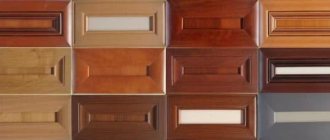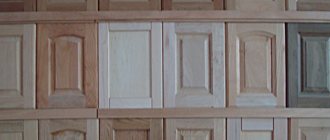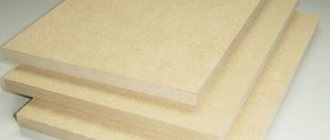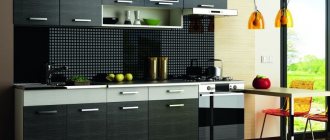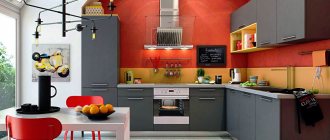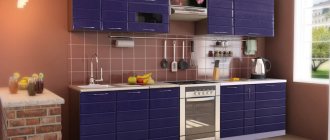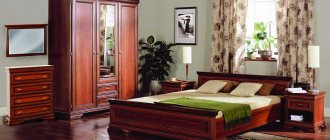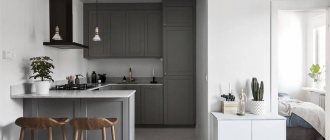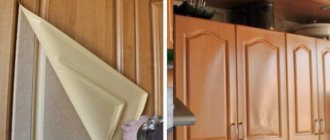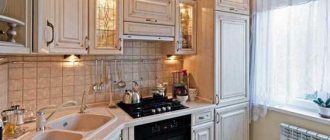What are acrylic facades?
At first glance it may seem that the panels are made of plastic. This is wrong. Thin MFD or chipboard panels are covered with special sheets of polymethacrylate, more often called acrylic.
MDF panels coated with acrylic.
This helps to ensure not only strength, which is important for furniture facades, but also wide design possibilities, as well as a characteristic glossy shine. MDF with acrylic coating is absolutely harmless, does not emit toxins when heated, and with proper care will last for many years.
High-gloss acrylic panels are easy to clean and do not fade over time. In addition, the properties of acryline help it not to absorb dirt and grease.
Order an acrylic kitchen from the manufacturer on our website
Buy a kitchen with acrylic facades at Ulyanovsk Kitchens at an affordable price! Check out photos of acrylic kitchen interiors. You can order an acrylic kitchen of any configuration and size. Need a specialist opinion? Book a consultation on our website. You can purchase a custom-made kitchen or buy a ready-made set in Moscow and the region in our online store or by visiting a shopping center in Lyubertsy. For additional information, contact us in any convenient way.
Manufacturing technology of acrylic facades for kitchens
There are two ways to manufacture such facades: one-sided and two-sided. In the first case, the acrylic sheet is glued only to the outer part, leaving the inner part untreated. In the second, both sides of MDF or chipboard are glued, providing the doors with the same appearance from the inside and outside.
The coating is glued using a special glue (for example, Cosmofen or Akrifix), and then placed under a press. In this case, the sections are covered with a waterproof acrylic edge, which prevents peeling of the decorative layer. The thickness of such a facade often does not exceed 16-18 millimeters.
A more expensive option is solid acrylic panels up to four millimeters thick, edged with aluminum. Metal adds strength to them, comparable to chipboard, but they are much more difficult to maintain and are quite expensive.
What is acrylic and how is it made?
Acrylic
- methyl methacrylate polymer, that is, the same plastic, but with new properties. It has not been used in kitchen production for long, but it already occupies a leading position, and this is justified. Due to its properties, the material is excellent for the manufacture of kitchen furniture, and its non-standard appearance will transform the room beyond recognition.
Acrylic kitchen facades are usually made in this way: a wood board is covered with thin sheets of acrylic and put under a press. The thickness of the main plate is 16-18 mm, the acrylic coating is 1-3 mm. The base for acrylic coating can be MDF or chipboard, but the second is used less often. Although the cost of such a board is lower than MDF, in other respects it loses: it is less durable and deteriorates more quickly from moisture and steam. Therefore, for the manufacture of acrylic kitchens, it is more advisable to use an MDF board as a base. The furniture factory "Kitchen Biograph" uses only MDF for the manufacture of acrylic facades.
Advantages of MDF:
- more resistant to moisture and temperature changes;
- stronger than chipboard, does not deform over time;
- does not affect the color of facades;
- The structure is more suitable for pasting with acrylic.
Acrylic coating comes in two types:
- Panels.
When producing facades covered with acrylic panels, the MDF board is treated with a hardener and a special primer, and UV paint is applied on top, which determines the color of the panel. To fix the color, the slab is irradiated with ultraviolet light and colorless acrylic 2-3 mm thick is applied on top under pressure. - Films.
Decorative multilayer paper 1 mm thick, impregnated with absorbent and acrylic resin. It is glued to an MDF or chipboard using high temperature and a press.
If we compare an acrylic panel and a film, they only have the same degree of gloss and color variety. That is, in appearance they are not much different, but the wear resistance and strength of the panel are higher. A thinner film is easier to damage, it is not protected from scratches, and is less resistant to ultraviolet radiation. But the film can also be applied to curved facades. Panels come in only straight shapes. The Morocco kitchen uses acrylic film from Turkey.
3D acrylic coating
- a new fashionable accent. A design is applied to the MDF board using special paints and covered with acrylic on top. A volumetric effect is created. On our website, the Orlando kitchen is presented with 3D acrylic coating.
On a note
Which facades to choose for the kitchen: acrylic, plastic or enamel? The enamel is not protected from mechanical damage, although its surface can be restored. Plastic, compared to acrylic, is less resistant to temperature changes and humidity; fades in the sun. Taking into account these features, choose what is more preferable for you.
Pros and cons of kitchens with acrylic facades
In addition to appearance and ease of installation, such facades have a number of advantages:
- Wear resistance. The strength of acrylic reliably protects it from damage due to impacts and scratches. In addition, damaged acrylic panels can be reconstructed to their original appearance. With proper care, they will last up to 20 years.
- Acrylic does not react to temperature changes and is resistant to heating up to 160 degrees. It does not deform when exposed to water, and does not fade from sunlight.
- Grease, soot and dust are not absorbed into the surface ; it can be easily cleaned with a simple detergent and a soft cloth. We recommend: Once every three to four months, treat facades with sprays that help maintain a glossy shine, for example, Weiss or Cosmofen.
- Large selection of design solutions. Acrylic panels are presented in a wide palette. In addition, you can decorate them with prints or airbrushing or decoupage.
- The glossy structure due to its reflective properties makes the room lighter and more spacious .
- Acrylic panels, unlike plastic ones, do not release toxic impurities into the air when heated. Therefore, acrylic can be considered an environmentally friendly material.
However, it was not without its drawbacks:
- Due to the manufacturing technology, acrylic facades are quite expensive . The cost of a solid acrylic facade can reach $600 per linear meter, and an acrylic coating can cost $100. At the same time, taking into account the quality, the price can be considered relatively affordable: the long service life fully pays for the costs of manufacturing and installation.
- The glossy surface is very difficult to handle. It does not scratch or chip, but any fingerprints and dust become much more noticeable. You will have to regularly wipe away streaks and stains. Please note: Special grease-repellent polishes will help prevent the problem.
- High shine. The disadvantage is conditional, but over time many people begin to be annoyed by the glossy mirror structure of the acrylic facade.
Competent care
You need to know simple rules for using glossy facades, in addition to wiping them daily. If the contamination is minor, then you can get by with soapy water and a soft cloth for daily care. On days when the acrylic kitchen is not in use, there is no need to wipe the furniture, since the perfectly flat surface does not trap even particles of dust.
Manufacturers guarantee long-lasting facades, acrylic on which is one of the materials that can withstand fairly intense impacts. If a small defect does appear, then it is enough to level this area with sandpaper and then polish it.
After its final installation, the protective film that protected it during storage and transportation is removed from new furniture. Opened to external influences, modern acrylic facades must adapt to the atmosphere of the kitchen. Of particular importance is the fact that when exposed to high humidity, acrylic becomes harder. If no additional steps are taken, the process of adapting an acrylic kitchen takes almost 70 hours.
Experts recommend immediately wiping new acrylic facades with a soft cloth soaked in a low concentration soap solution.
There are special products without an alcohol component and without harsh abrasives that create conditions for acrylic to harden and prevent stains or scratches from appearing.
What is better to choose for kitchen facades: acrylic or plastic?
As mentioned above, acrylic is much more environmentally friendly than plastic. But is this the only difference? We offer a comparative table of the two materials.
| Acrylic facades. | Plastic facades. | |
| Gloss. | Clearly expressed, with a mirror shine. | Compared to acrylic, plastic is duller. There are matte options. |
| Temperature resistance. | It tolerates heating up to 160 degrees without releasing toxic impurities. | Good HPL or CPL plastic can withstand temperatures up to 140 degrees, but cheap options begin to release toxins at 80 degrees, so they should not be placed near the stove. |
| Term of use. | With proper use - up to 20 years. | After just a couple of years, it may begin to fade from heat and direct sunlight. |
| Price. | High-quality acrylic will cost you quite a lot. | Affordable price. |
| Facade type. | Only deaf. | Deaf and radius. |
Let's summarize: Acrylic facades are more durable and reliable, but the price is not encouraging. At the same time, plastic facades are more affordable, but they are more capricious in everyday use and they cannot be placed next to heat sources.
Acrylic facades in modern interiors
Acrylic facades have a place in every modern interior. It looks most harmonious in a space decorated in high-tech style. The kitchen facade is characterized by a pronounced shine and rich color shades, and therefore it looks most advantageous in modern stylistic solutions. To complement the picture of the kitchen set and organically fit it into the surrounding space, the furniture can be supplemented with a beautiful table and chairs of a non-standard shape with glossy surfaces.
Designers recommend finishing walls in light, neutral colors: beige, white, gray, cream, pale yellow, light brown and champagne. Such solutions allow you to turn kitchen furniture into a color accent that instantly attracts attention. Sets with acrylic fronts fit organically into an industrial-style space. If you are attracted to this solution, give preference to dark tones of acrylic surfaces. A chrome refrigerator, graphite hood and other kitchen appliances in dark colors will be an excellent addition to the overall design. When decorating a kitchen space, metal elements would be extremely appropriate.
If you are attracted to acrylic facades in rich colors, then it is better to install them in a room with white or light decoration. In this case, walls and horizontal surfaces will help create the floating effect. If you plan to cook in the kitchen frequently, then the cleaning process will be fraught with certain difficulties. A competent approach to choosing the overall design of the space will allow you to turn a banal acrylic kitchen into a highlight of any style. Do not limit your own imagination to create your own, original design of the kitchen space.
What color should acrylic facades be made in?
The design palette for acrylic facades is extremely wide. Many colors and shades, the possibility of decorative design. We invite you to look at the most popular options among designers - perhaps you will find your ideal kitchen.
A white acrylic kitchen is a great choice for small spaces. Due to the color and glossy texture, it reflects light, visually enlarging the room and making it lighter and more spacious. However, keep in mind that such facades are very difficult to maintain - all the dirt and drops of grease are visible on the white surface, so you will have to wash the set often.
An interesting solution is a black and white acrylic kitchen . The classic combination looks very catchy thanks to the mirror shine. However, it is important to maintain a balance here: it is better if the colors are combined with each other, and do not overwhelm each other.
If such a combination seems boring to you, dilute it with another shade - it is better to choose bright colors, for example, pink, light green, blue.
Bright red is on trend right now, but we recommend being careful with it. Aggressive tones quickly tire the eyes, so monochromatic design in this case is not the best choice. Dilute it with calmer, pastel shades - beige, gray, golden.
The same applies to yellow kitchens . However, it all depends on the chosen tone. Soft colors will make the kitchen fresh and brighter, but bright colors require a muted edging.
A monochrome black kitchen is a bold but very stylish solution. It is important to pay attention to details: any inappropriate accessory, the slightest contamination - and the impression is ruined.
Peculiarities
In the manufacture of kitchen furniture, MDF products coated with acrylic are used.
The complexity of the technology lies in the fact that it requires special conditions. The process takes place at high temperature and pressure. Thanks to this, there is a strong adhesion of the base to the acrylic.
After applying the coating, they proceed to cutting the material. This operation is performed taking into account the dimensions of the facade. Then the ends of the headset are processed.
Manufacturers of acrylic kitchen facades
Acrylic panels are produced by dozens of manufacturers with very different pricing policies.
We offer you the TOP 3 manufacturers popular in Russia:
- Bel Viso using NIEMANN panels. Polish acrylic facades are one of the most famous. A wide selection of decorative designs, a huge color palette and high quality. The price, however, is appropriate - from $150 per linear meter.
- The Sidak company , located in the Leningrad region, will also not please you with the price tag - from $140 per meter. However, the factory goes through the full production cycle: from the panel to the finished facade, which affects the quality.
- Fordom is a more budget option. Turkish facades will cost you an average of $90 per meter. Of course, you can also find cheap acrylic facades. But be careful - most often the tempting price tag hides a low-quality coating or simple plastic, sometimes not even heat-resistant.
Acrylic kitchens - ideal value for money
Plus, in addition to all its advantages, the price of acrylic facades is less than other types: for example, solid wood, veneer, MDF with enamel coating. Natural wood is always in price because of its presentability and uniqueness. But acrylic has a lot of other advantages that wood does not have: for example, resistance to changes in temperature and moisture, and ultraviolet radiation. Acrylic facades with an MDF base are more expensive only than thermoplastic and PVC film, which are inferior in quality characteristics. But compared to enamel, acrylic is more wear-resistant, but costs less. If you choose acrylic film rather than panels, you will get an economy class kitchen for the price.
| Kitchen "Orlando" | Kitchen "Morocco" |
On our website “Kitchens Biograph” prices for acrylic kitchens range from 20,000 to 25,500 rubles per linear meter (price may vary). For comparison: kitchens made of solid ash - from 28,500 rubles. per m.p.; kitchens coated with Italian enamel - from RUB 28,500. per m.p.; from PVC film with patina - from RUB 15,500. per m.p.; made of thermoplastic - from 17,000 rubles. per m.p. The minimum cost of ready-made acrylic kitchens is 50,000 rubles.
Reviews from real owners of acrylic kitchens
If you look at the reviews of people who bought acrylic facades for their kitchen, you will notice one common point - everyone admires their beauty and durability, but emphasizes the capriciousness of their care. Most often, this means the need for regular cleaning.
However, some people think that wiping the facade once a month is enough, but the only disadvantage is the cost.
And some people don’t like the need to use special care products.
Sometimes a change in shade depending on the lighting is noted. Therefore, be careful with pastel colors - in the twilight they may appear dull.
However, the reviews are unanimous on one thing - acrylic facades are reliable, durable and beautiful.
Finishing the apron with acrylic panels
An apron is the section of wall between the work surface and the wall cabinets in the kitchen. If the upper tier of the headset is missing, then the apron refers to the entire wall. This place gives the housewife a lot of trouble: constant splashes of grease that appear from the stove during cooking, a coating of soot spoils the entire appearance of the kitchen. Tired of constant cleaning, owners abandon washable wallpaper and wall panels in favor of ceramic tiles, which are much more practical to use: easy to clean and resistant to temperature changes. However, over time, fungus forms at the joints of the plates due to excess moisture. It is difficult to deal with it, so manufacturers have found a unique way out of the situation: covering the apron with acrylic panels.
This type of tempered glass is better known as stalinite. The monolithic slab has no seams and is manufactured individually for each customer, depending on the required parameters. It can be up to three meters long and the design looks amazing. Thanks to large-format printing, an image is applied to the panel from the inside, which is firmly fixed in the glass. The design is reliably protected from water and grease, is not afraid of direct sunlight, and is therefore not subject to fading or fading. Here you can choose a picture to suit any design and every taste: from an appetizing still life to a picturesque underwater world. An apron made of tempered glass with spot lighting mounted in the bottom of wall cabinets looks especially impressive. Thus, the work area receives good lighting and becomes the highlight of the entire interior.
Acrylic glass is much stronger than silicate glass and is much more difficult to break.
Stalinite does not lose its shape and is not afraid of temperature changes. The material begins to melt only at a temperature of 160 degrees, so it can safely be located next to the stove. Its glossy reflective surface visually enlarges the room, giving it lightness and airiness. The tempered glass apron harmonizes perfectly with the acrylic facades of the kitchen set.
How to care for acrylic facades
As can be seen from the reviews, the main problem with acrylic facades is their maintenance. How to properly care for the panels?
Now we'll tell you:
- Do not use aggressive abrasive detergents.
- When choosing what to wash the panel with, stick to the mildest possible detergents - for example, regular dishwashing detergent.
- Use lint-free soft cloths.
- Wipe the surface regularly to prevent fingerprints and dirt from accumulating on it.
- Use polish for acrylic kitchen facades - it will make cleaning much easier.
Let's summarize: With proper care, an acrylic facade is an excellent choice for kitchen design. A beautiful, eco-friendly and durable set will become a real decoration of the room. Among the disadvantages, we note the high price - however, taking into account the durability of such furniture, it is completely justified.
Acrylic kitchens: choose matte or glossy?
Such kitchens are made only in the Art Nouveau style, because they have exclusively straight facades without insets, milling, overlays, etc. But they can be either matte or glossy. At the Biograph Kitchens factory they make acrylic furniture with glossy and matte facades. It can also be of any configuration: angular, straight, U-shaped. When choosing, consider some features:
- glossy surfaces need to be wiped more often;
- with matte it is more difficult to remove dirt;
- light reflection is more impressive in gloss;
- a calm matte kitchen is suitable for a room on the south side - there will be no glare.
Matte acrylic kitchen
Glossy acrylic kitchen
Kitchens with acrylic facades photo examples
How to choose the best facade
What is better: acrylic or plastic, or maybe enamel? Their properties are largely similar. Look at the photos in manufacturers' catalogs and choose the facades that you like best. But if you decide to choose acrylic, remember: gloss needs to be washed regularly, and this must be done very carefully. Not all means are suitable for this.
Some manufacturers of acrylic boards produce entire lines of furniture care products. Find out which ones will suit you.
If there are small children in the house, then it is better to hold off on buying an acrylic kitchen. Firstly, you will have to regularly wipe it off little fingers. And secondly, the child’s psyche is not yet ready for the play of reflections on mirror surfaces, for which acrylic facades are loved.
Problem #1. The entire facade is stained and stained
We dare to assume that you already have a whole arsenal of detergents and cleaning products on your shelf, you constantly wash and rub your kitchen furniture, but it still has “fingers” and drops all over it. These are the first questions gloss lovers might have.
p, blockquote 3,0,0,0,0 —>
How to remove fat?
There are now many products on sale for degreasing dishes and furniture. You can even use regular Fairy, Persil and the like. Apply the gel to a microfiber cloth, lather and wipe the facades with it. Then rinse with clean water and wipe the surface dry. For the last step, it is better to use disposable rags in rolls.
p, blockquote 4,0,0,0,0 —>
p, blockquote 5,0,0,0,0 —>
Life hack: for express care of glossy furniture, you can use ordinary wet wipes, even the cheapest ones. If you walk them over your headset every day, you can avoid streaks and maintain its neat condition.
True, this method is not suitable for general cleaning. Therefore, if you fry with an open lid and splashes of fat get on the furniture, do not be lazy and immediately wipe it with a cloth before the fat “petrifies”.
p, blockquote 7,0,0,0,0 —>
p, blockquote 8,0,0,0,0 —>
What products can and cannot be used?
Remember the golden rule: under no circumstances use abrasives or substances with an aggressive composition when cleaning. A glossy kitchen cannot be washed with products that contain powder, solvent or acid - this will only erase the surface and it will become covered with small cracks and scratches.
p, blockquote 9,0,0,0,0 —>
p, blockquote 10,0,0,0,0 —>
A glossy set is very easy to spoil with cleaning powders such as Pemolux or Comet. Moreover, their destructive effect will not be immediately noticeable, but over time the gloss may become cloudy or yellow.
p, blockquote 11,0,0,0,0 —>
Products with bleach will “help” you discolor facades - such as White, Domestos, Toilet duck, Cilit Bang.
p, blockquote 12,0,0,0,0 —>
p, blockquote 13,0,0,0,0 —>
Alcohol-containing substances are also not recommended - they cause the gloss to fade and lose its original appearance.
p, blockquote 14,0,0,0,0 —>
The detergents must not contain the following components:
p, blockquote 15,0,0,0,0 —>
- alcohol;
- acetone;
- chemical solvent;
- turpentine;
- nitroglycerine;
- synthetic resin;
- chlorine.
The presence of these components may damage the glossy finish.
p, blockquote 16,0,0,0,0 —>
p, blockquote 17,0,0,0,0 —>
You can use multi-purpose cleaners such as Edelweiss, glass washing liquids (without alcohol), polishes for glossy furniture. Everything you need will shine.
p, blockquote 18,0,1,0,0 —>
Any dishwashing detergent with a degreasing effect will do.
p, blockquote 19,0,0,0,0 —>
Stores now sell special products that create a protective crystal-like film and prevent the formation of stains on glossy furniture (Amway, Ultra Gloss, VuPlex). Typically, the procedure needs to be performed every 6–12 months.
p, blockquote 20,0,0,0,0 —>
p, blockquote 21,0,0,0,0 —>
What cloth to wipe with?
Microfiber is your friend forever. You can also use flannel or flannelette fabric, disposable wet wipes, or special cloths for washing car windows, which are sold already damp in containers.
